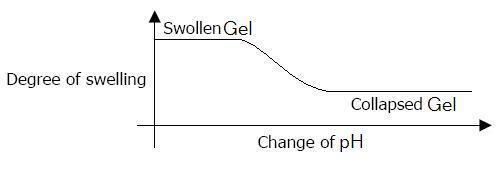 | ||
pH sensitive or pH responsive polymers are materials which will respond to the changes in the pH of the surrounding medium by varying their dimensions. Such materials increase its size (swell) or collapse depending on the pH of their environment. This behaviour is exhibited due to the presence of certain functional groups in the polymer chain.
There are two kinds of pH sensitive materials: one which have acidic group (-COOH, -SO3H) and swell in basic pH, and others which have basic groups (-NH2) and swell in acidic pH. Polyacrylic acid is an example of the former and Chitosan is an example of the latter. The mechanism of response is same for both, only the stimulus varies.
The response is triggered due to the presence of ionisable functional groups (like -COOH, -NH2) which get ionized and acquire a charge (+/-) in a certain pH. The polymer chains now have many similarly charged groups which causes repulsion and hence the material expands in dimensions. The opposite happens when pH changes and the functional groups lose their charge hence the repulsion is gone and the material collapses back. These materials are being extensively used in controlled drug delivery systems, biomimetics and responsive plasmonics.
The most common pH-responsive polymer structures described in the literature are linear homopolymers, amphiphilic, and double hydrophilic block copolymers which form micelles or vesicles, star, branched, and hyper-branched polymers, polymer brushes, dendrimer polymers, nanogels, microgels, and hydrogels (macrogels).
